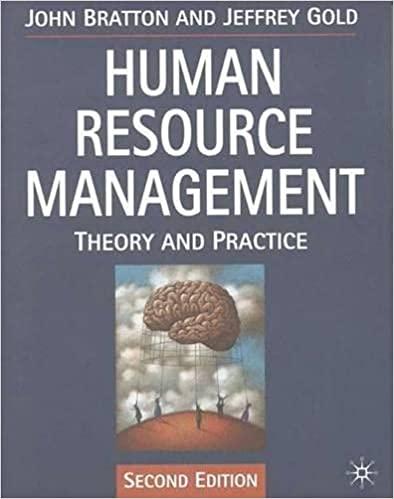3. To what extent is HRM different from conventional personnel management or is it simply 'old wine...
Question:
3. To what extent is HRM different from conventional personnel management or is it simply
'old wine in new bottles'?
Servo Engineering was founded in 1897 to manufacture an improved miner's safety lamp.
Over the last fifty years the company has developed as a leading manufacturer of commercial vehicle components. In 1965 Servo Engineering became a subsidiary of Zipton Holding Ltd, which merged in 1977 with American Ensign. This multinational company has manufacturing plants in the UK, USA and Germany. In 1998 the UK group had four sites in the UK.
Between 1994 and 1998 the company replaced over half its conventional and numerical control machines with computer numerical control. In 1995 the firm organized production into six 'self-managed teams' (SMT). The SMTs were product-centred; for example, one SMT would manufacture a whole component such as vacuum pumps or air compressors.
Each SMT operated as a miniature factory within the larger factory. Each SMT had sufficient machinery to complete the majority of the manufacturing stages. Processes outside the scope of the SMT were subcontracted, either to another SMT, or to an external contractor. The number of workers in each SMT varied between 12 and 50. The SMT operated a three-shift system: 6 am to 2 pm, 2 pm to 10 pm, and 10 pm to 6 am. The division of labour within the SMT is shown below. The 'SMT supervisor' had overall responsibility for the SMT. The product coordinator's job was to ensure the supply of raw materials and parts to meet SMT production targets. The 'charge-hand' acted as progresschaser.
Below the supervisory grades was a hierarchy of manual grades reflecting different levels of training, experience and pay. For example, the 'setter' was apprentice-trained and was paid a skilled rate to set up the machines for the semi-skilled operators. Semi-skilled workers received little training. In total, the firm employed 442 people. Two unions were recognized by the firm for collective-bargaining purposes: AEEU and MSF. The AEEU was the largest union at the factory; it had 200 members out of a total of 351 manual workers, a union density of 56.9 per cent.
The personnel manager at the factory was George Wyke, who had worked for the company for 25 years. Prior to becoming the personnel manager, he was an AEEU shop steward. He had no formal personnel management qualifications. The company gave SMT leaders considerable discretion for employee relations. To quote George Wyke:
What the STM system has done as far as man-management [sic] is concerned, it has pushed that responsibility further down the chain, into the SMTs. So where somebody wants disciplining, they don't say to the personnel manager: 'I want to sack this bastard.
What can I do to get rid of him?' They know what they have got to do. The only time they will come to me is to seek advice on whether they are doing it right or wrong.
Although levels of unemployment were high in the area, the company had difficulty recruiting 'good' people at its factory in Yorkshire. Also, absenteeism and turnover were high, as shown below.
Absenteeism 1998 Turnover Rates 5.3 January 34.4 5.7 February 20.4 8.0 March 27.5 The apparent low level of commitment among manual employees can be explained in two ways. First, shop stewards and workers expressed considerable discontent over the bonus scheme; the standard time allowed to complete a particular task was not considered adequate to earn a 'decent' bonus. Second, the way the SMTs were designed resulted in operatives performing narrow, repetitive tasks, closely supervised. The personnel manager, George Wyke, is due to retire this Christmas. The plant manager, Elizabeth Bell, has been concerned for some time over employee relations in the factory and the management style of George Wyke and some of the SMT leaders. Elizabeth Bell has decided to seek an external candidate to replace the incumbent personnel manager.
Gleaning through the advertisements in newspapers and journals she also decided to drop the term 'personnel' and advertise for a 'Human Resource' Manager.
(Source: Adapted from 'The Motor Components Company: Japanization in Large-batch Production', in Bratton, J. (1992) Japanization at Work, London: Macmillan).
Questions 1. Describe the main features of George Wyke's approach to HR management. How does Wyke's approach differ from the stereotype HRM approach?
2. Discuss the contribution an HRM professional could make to the company.
Step by Step Answer:

Human Resource Management Theory And Practice
ISBN: 9780333732083
2nd Edition
Authors: John Bratton, Jeffrey Gold





